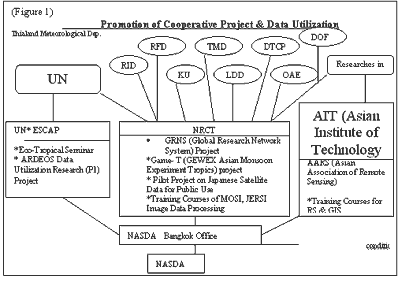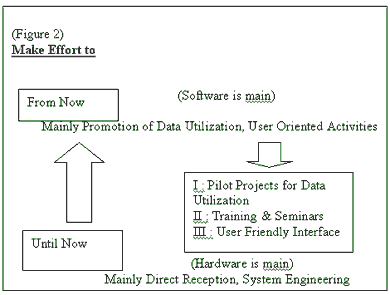| GISdevelopment.net ---> AARS ---> ACRS 1997 ---> Education/Training |
NASDA's Remote Sensing
Activities In Thailand
Mr. Masaru
Tsukamoto
Bangkok Office, Nanda (National Space Development Agency of Jaapan )
B.B.Bldg. 1312, 54 Ashoke Rd., Sukhumvit 21, Bangkok, 10110 Thailand
Tel: (66)-2-260-7026 Fax :(66) -2-260-7027
E-mail : nasdatha@ksc15.th.com
1. Present state of utilization of Japanese
Satellite data Bangkok Office, Nanda (National Space Development Agency of Jaapan )
B.B.Bldg. 1312, 54 Ashoke Rd., Sukhumvit 21, Bangkok, 10110 Thailand
Tel: (66)-2-260-7026 Fax :(66) -2-260-7027
E-mail : nasdatha@ksc15.th.com
NASDA (National Space Development Agency of Japan) was established in 1969 in order to act as the center for implementing space development and promoting space utilization exclusively for peace purpose. NASDA's main activities are to develop satellites and vehicles, to launch and track vehicles and satellites, to promote space experiments to promote utilization of remote sensing data from satellites, to research and develop. Recently, in the above several NASDA's activities, remote sensing activities have been paid more attentions. I am roughly thinking that the aim of NASDA's activities is now changing. Until now that was mainly establishment of domestic space basic technologies. We have now established. From now that will changing towards mainly development of useful space technologies for all over the world and humanity. In this point of view I think the first step of useful space technologies is remote sensing space.
NASDA has two main roles in Thialand. The first role is the direct reception of Japanese satellite date in Bangkok ground station in cooperation with NRCT (National Research Council of Thialand).In this station, NASDA is in charge of the establishment and maintenance of facilities. On the other hand, NCRT supplies building,electricity, and operates the facilities for the data reception and processing, and distributes the processed data to users in not only Thialand but also South-east Asia. Then NASDA & NCRT are in charge of the promotion of Japanese satellite data utilization in South-east Asia. The second role is the promotionof cooperative project and data utilization. Through UN-ESCAP, NASDA is holding the regional remote sensing seminar on tropical ecosystem management every year from 1992. We are also conducting ADEOS PI (Principle Investigator) project in cooperation with UN-ESCAP. We selected 20 PIs in Asian countries, provided ADEOS data to support them. Through NCRT, NASDA is conducting GRNS (Global Research Network System ) project from 1993, GAME-T (GEWEX Asian Monsoon Experiment Tropics) project from 1996 for the purpose of making basic and scientific data. Pilot project on Japanese satellite data for public use in Thialand has started this October in Cooperation with NRCT and four Thai departments. Through AIT (Asian Institute of Technology) & AARS (Asian Association of Remote Sensing), we are conducting some kinds of training courses for Asian users and are studying measures for the promotion of Japanese satellite data utilization (Figure 1).

2. Needs requested by researches to NASDA
There have been few research results using Japanese satellite data of Asian region until now. When AIT investigated ACRS proceedings, ESCAP journals etc, there were only six research papers utilizing Japanese satellite data of Asian region out of about 1,000 research topics. NASDA Bangkok office and AIT have conducted the questionnaire survey in order to find out the obstacles for data utilization, investigate the user's need and improve the data distribution dydtem. We got altogether 136 respondent's answers from researchers related to remote sensing fields in Asian region. The outline of this questionnaire survey results sre as follows (Table 1~10).
94 researches have experienced utilization of remote sensing satellite data out of 136 surveyed respondents. The type of satellite data used by experienced respondents are Landsat-TM 78%, SPOT 50%, Landsat-MSS 28%,NOAA 21%, JERS-OPS 12% etc.. The main reasons for not using Japanese satellite data are "Difficult to get/purchase", "Do not know how to request Japanese satellite data", "Easy access to other data", " Required coverage/data is not available". The problems encountered in reading satellite data are " Software cannot deal with the media", "Infrastructure hard disk capacity", "Too complicated procedure" etc.. The problems in purchasing data are "Expensive" etc.. The suggestions to promote Japanese satellite data are " Joint research project on Japanese satellite data", " Pilot project with applications", "Providing information to users", 'Training & Seminar " etc.. Generally speaking from what we surveyed, Japanese satellite data has not been utilized s much. I think there are no problems in data quality itself, but some difficulties to access and deal with data.
3. Data utilization scheme and measures to promote data utilization
Therefore we are now changing our efforts from mainly direct reception and system engineering towards mainly promotion of data utilization and user oriented activities, that is so-called from hardware to software (Figure 2)

I think this user oriented activities are composed of three factors in the data utilization scheme. The first factor is the pilot projects for capable users to promote data utilization. The second factor is the trainings and seminars for potential users. The third factor is the user friendly interface. The first & second factors are very important and the activities in these factors have been already explained in the promotion of cooperative project and data utilization above-mentioned. The third factor is also much important. However we have not managed this third factor so successfully. I would like to emphasize that we need smooth & rapid service system & organization. For example, we have to establish the good catalogue system and prepare the library of useful data of less than cloud 10%. We had better distribute the data by CD-ROM and in the useful data format for users. Our coverage map should be more useful including main rivers, main cities, country-province border lines etc.. The data promotion by mosaic data is much beneficial. We have to deliver the general informations to many users periodically (Figure 3). I think the combination of these three factors is important. Now NASDA Bangkok office would make efforts to improve these three factors of user oriented activities, because I think Japanese satellite data should be utilized more efficiently & widely in Asian countries than until now.

Table 1. Status of Remote Sensing Satellite Data Users in Surveyed Respondents.
| Experienced | 94 |
| Non-Experienced | 42 |
| Total | 136 |
| Indian | 2 |
| Japanese | 5 |
| Lao | 5 |
| Myanmar | 2 |
| Nepali | 8 |
| Philippino | 2 |
| Srilankan | 1 |
| Thai | 67 |
| Vietanamese | 2 |
| Total | 94 |
| Government service holder | 30 |
| Staff in company | 5 |
| Staff in occupation | 3 |
| Staff in university | 18 |
| Student | 10 |
| University | 28 |
| Total | 94 |
| Field of Research | F' | Proportion(f*100)/94 |
| Agriculture | 16 | 17.02 |
| Atmosphere | 1 | 1.06 |
| Cartography | 2 | 2.13 |
| Coastal resources | 2 | 2.13 |
| Disaster | 6 | 038 |
| Environment | 7 | 7.45 |
| Forestry | 19 | 20.21 |
| Geography | 1 | 1.06 |
| Geology | 5 | 5.32 |
| Hydrology | 10 | 10.64 |
| Image Production | 7 | 7.45 |
| Landuse | 35 | 37.23 |
| Marine | 2 | 2.13 |
| Pollution | 1 | 1.06 |
| Security | 1 | 1.06 |
| Soil | 10 | 10.64 |
| Soil Erosion | 4 | 4.26 |
| Transportation | 1 | 1.06 |
| Urban Planning | 3 | 3.19 |
| Not mentioned | 27 | 28.72 |
| Total | 160 | 170.21 |
| Satellite Data Types | f' | Proportion(f'*100)94 |
| Landsat Tm | 73 | 77.66 |
| Landsat MSS | 26 | 27.66 |
| SPOT | 47 | 50.00 |
| IRS | 4 | 4.26 |
| NOAA | 20 | 21.28 |
| ERSI | 10 | 10.64 |
| MOSI | 3 | 3.19 |
| Radarsat | 8 | 8.51 |
| JERS OPS | 11 | 11.70 |
| JERS SAR | 3 | 3.19 |
| ADEOS | 1 | 1.06 |
| KFA 1000 | 1 | 1.06 |
| Not mentioned | 14 | 14.89 |
| Total | 221 | 235.11 |
| Reasons not using JSD | f' | Proportion (f'*100)/94 |
| Availability of other data free of cost | 10 | 10.64 |
| Difficult to get/purchase | 18 | 19.15 |
| Do not Know how to request JSD | 17 | 18.09 |
| Do not know Japanese Satellite Data | 13 | 13.83 |
| Easy access to other data | 16 | 17.02 |
| Low resolution | 9 | 9.57 |
| Not good data | 10 | 10.64 |
| Not suitable spectral range | 5 | 5.32 |
| Required coverage/data not available | 14 | 14.89 |
| Not mentioned | 33 | 35.11 |
| Total | 145 | 154.26 |
| Types of Problem | f' | Proportion (f'*100)/94 |
| Format not compatible | 2 | 2.13 |
| Insufficient hard disk capacity | 13 | 13.83 |
| No appropriate device | 3 | 3.19 |
| Software can not deal with the media | 15 | 15.96 |
| Too complicated procedure | 10 | 10.64 |
| Not mentioned | 65 | 69.15 |
| Total | 108 | 114.89 |
| Types of problem | f' | Proportion (f'*100)/94 |
| Expensive | 12 | 12.77 |
| Time consuming | 5 | 5.32 |
| Lack of good service center | 1 | 1.06 |
| Delay in arrival of data | 1 | 1.06 |
| Data selection | 1 | 1.06 |
| Others (service..) | 4 | 4.26 |
| Not mentioned | 71 | 75.53 |
| Total | 95 | 101.06 |
| Suggestion | f' | Proportion (f'* | 100)/94
| Accessibility should be easier | 4 | 4.26 |
| Better data distribution system | 4 | 4.26 |
| Data user service provide | 2 | 2.13 |
| Easy handling of PC for JSD | 1 | 1.06 |
| Good archieve system | 1 | 1.06 |
| Improve data acquiring cycles | 1 | 1.06 |
| Improve data quality | 1 | 1.06 |
| Improve resolution | 1 | 1.06 |
| Joint research project on JSD | 13 | 13.83 |
| Lower price | 1 | 1.06 |
| Maintain users data base | 2 | 2.13 |
| Map scale 1:10,000 | 1 | 1.06 |
| Meta data insufficient | 1 | 1.06 |
| More receiving stations | 1 | 1.06 |
| Pilot project with applications | 10 | 10.64 |
| Provide catalogue | 4 | 4.26 |
| Provide fund for research project | 1 | 1.06 |
| Provide informations to users | 10 | 10.64 |
| Training and Seminar | 10 | 10.64 |
| Not mentioned | 40 | 42.55 |
| Total | 109 | 115.96 |
| Financial | 10 |
| Technical | 5 |
| Both | 52 |
| Not mentioned | 27 |
| Total | 94 |